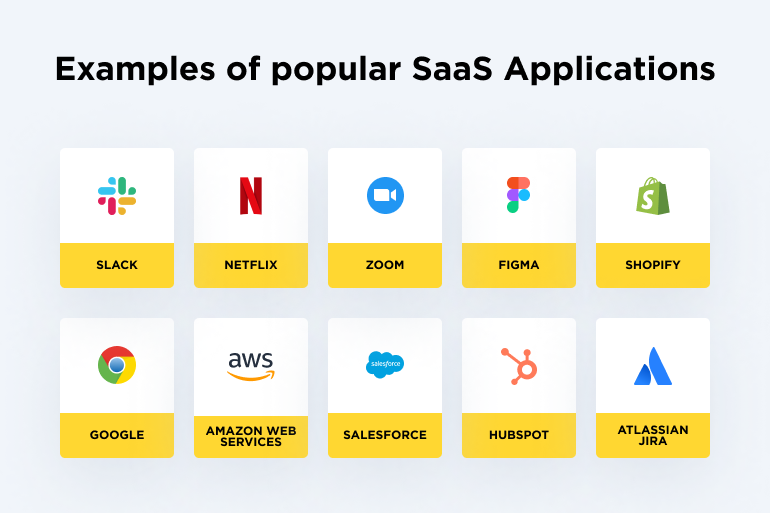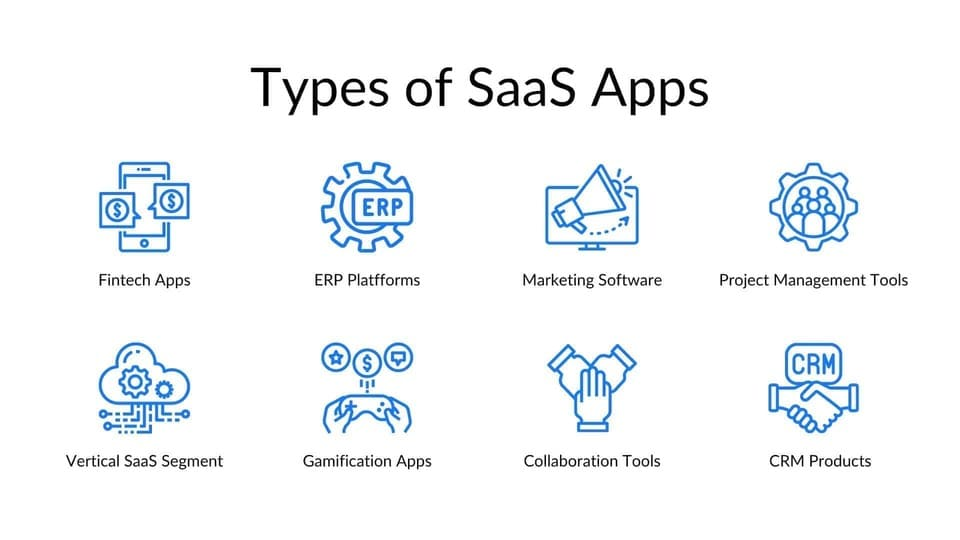SaaS offers huge potential for improving the efficiency and flexibility of business processes. In this article, we’ll look at the key security risks in SaaS applications and guide how to ensure secure operations and data protection.
The importance of security in SaaS applications
SaaS applications must keep user data secure. The developer must provide high privacy from unauthorized access, information leaks, and intruders.
Services run over the internet, so cybersecurity of the web infrastructure is a critical aspect. It includes password manager, backups against malicious attacks, DDoS attacks, authentication, and identification.
Privacy is related to risk management and compliance with rules and regulatory requirements. Developers must develop and implement security policies and keep up with changes in legislation and standards.

Top 6 SaaS security risks
Here is a list of the top 6 SaaS security risks you must know.
1. Unauthorized access
Approximately 36% of employees retained access to company systems even after departing from their roles. Given the presence of sensitive data, ensuring robust access control is imperative for all SaaS applications.
For enterprises utilizing SaaS solutions, evaluating whether the singular entry point to the cloud server might inadvertently expose confidential information is essential.
Risks arise from sharing passwords through insecure messaging platforms, email communications, and insufficient de-provisioning procedures. Such practices can result in unauthorized individuals, including former employees, maintaining access to critical applications. This alarming scenario opens the door to potential data breaches, as these individuals could exploit their access privileges within the application to steal sensitive information.
2. Shadow IT
A staggering 80% of employees openly admit to utilizing SaaS applications at work without obtaining prior approval from their IT department. This phenomenon, known as Shadow IT, raises various security concerns, including the absence of control, heightened vulnerability to data breaches, inflated expenditures, and the potential for data loss.
The rampant emergence of shadow purchases further exacerbates the situation, as these involve procuring unauthorized third-party applications without adequate due diligence. Consequently, these applications may not consistently adhere to the latest security regulations and compliance standards, exposing organizations to the grave risk of data breaches and regulatory violations.
To mitigate these risks, organizations must embark on a two-fold strategy. Firstly, they must proactively educate their employees about using unapproved applications. Secondly, companies should establish clear-cut rules and streamlined processes to effectively oversee and monitor the utilization of third-party apps within their corporate ecosystem. Doing so can bolster their security posture and minimize the risks linked to Shadow IT.
3. Poor compliance and regulation
Ensuring regulatory compliance and adhering to safety protocols is paramount for organizations to maintain robust cybersecurity practices. Even if your company maintains stringent internal compliance standards, relying on non-compliant SaaS providers can expose you to potential non-compliance issues.
For comprehensive SaaS compliance, consider the PCI DSS standard as an example, which mandates that enterprises must verify their vendors’ adherence to specific third-party risk management criteria. To mitigate this risk, your security team should consistently and rigorously assess SaaS suppliers for their compliance with industry standards and legal requirements.
Neglecting this crucial step could lead to severe consequences, including data breaches, substantial fines, and damage to your company’s reputation. Prioritizing vendor compliance is not just a matter of security but also a fundamental step in safeguarding your data and processes while ensuring they remain in accordance with the relevant regulations.
4. Misconfiguring the Cloud
A concerning 43% of organizations have grappled with security issues directly linked to misconfigurations within their SaaS environments.
In cloud systems, complexity often emerges as a multifaceted challenge. Developers construct these intricacies to bolster the security and reliability of each application. Nevertheless, this multi-tiered complexity amplifies the risk of misconfiguration mishaps occurring.
Regrettably, when security teams overlook seemingly minor vulnerabilities, the consequences can be far-reaching and enduring, affecting the broader infrastructure. Misalignments with security protocols create persistent headaches that are challenging to manage and rectify.
Adding to the complexity, a lack of comprehension regarding the inner workings and security prerequisites of SaaS applications perpetuates these security threats. To tackle these issues head-on, business security teams should adopt SaaS Security Posture Management (SSPM). SSPM empowers organizations with complete control and unparalleled visibility over their SaaS application stack, enabling them to proactively address security concerns and maintain a robust security posture.
5. Storage and data loss
A staggering 81% of organizations have experienced the exposure of sensitive data within their SaaS environments, underscoring the pervasive nature of data vulnerabilities and the critical need for heightened security measures.
The decision to store sensitive data within the SaaS landscape introduces a host of security concerns as organizations place their trust in third-party providers for data management and protection. Using vendor-owned servers amplifies the risks, potentially opening doors to illegal access, data breaches, and other dangerous threats.
Furthermore, cloud-based data storage, while convenient, remains susceptible to data loss or corruption due to connectivity issues, device failures, and unforeseen disasters. Businesses must exercise due diligence in selecting their SaaS storage providers, opting for reputable and trusted cloud service providers, and implementing robust data encryption practices when storing sensitive information.
Organizations should adopt a proactive approach and implement data backup strategies, regularly review retention policies, and strongly emphasize compliance with relevant regulations and laws. These measures are pivotal in preventing data loss while upholding the integrity and security of sensitive information.
6. Non-compliance
Ensuring the security of SaaS applications is a top priority, and one crucial aspect is verifying their compliance with necessary security audits and regulations. These certifications testify to the application’s ability to safeguard customer data effectively.
Unfortunately, some third-party SaaS vendors have gained notoriety for falsely claiming such certifications. Trusting these vendors can jeopardize your sensitive data’s security, making it imperative to steer clear of such applications.
However, the challenge arises when employees bypass official channels and procure these uncertified applications themselves (it is Shadow IT). This introduces SaaS security risks and underscores the need to actively prevent shadow IT within your organization.
To address these concerns, it’s crucial to implement measures that discourage unauthorized application purchases and usage by your users. Simultaneously, your SaaS security team must maintain a vigilant stance, scrutinizing all vendors to ensure their compliance with the stringent regulatory standards. This multi-pronged approach helps safeguard your organization against potential security breaches and data vulnerabilities.
Basic security measures in SaaS applications
Here are 3 basic security measures that SaaS applications use.
1. Authentication and access control
Companies should provide authentication mechanisms using strong passwords, two-factor authentication, and other identification methods. In addition, access control allows you to control user rights and grant rights only to necessary functions and data.
2. Data encryption
Data encryption is an important tool to ensure privacy. Vendors should use strong encryption algorithms to protect data at rest and transmitted over the network. This helps prevent unauthorized access to information even if the network is leaked or compromised.
3. Threat monitoring and detection
Threat monitoring and detection systems allow SaaS application providers to respond to potential attacks or security breaches. These systems continuously monitor in-application activity, network traffic, and abnormal behavior to quickly react to potential threats and prevent their effects.
Recommendations for security in SaaS applications
Here are recommendations that will help you maintain high security.
1. Validate the developer
First, thorough due diligence on the company’s credibility should be conducted. Ensuring the vendor has the appropriate certifications, ensures data encryption, and performs regular audits is important.
2. User training
Users of SaaS services should be trained on basic security principles, such as creating strong passwords, not opening suspicious links or attachments in emails, and regularly updating applications. The developer can provide training materials and user guides.
3. Regular data backups
Regular data backups are an important aspect of stability during outages or attacks. The developer should provide regular data backups and verify the integrity of the data.
4. Multi-layered security
Multi-layered security is effective. It combines measures such as physical protection of servers, firewalls, updates and patches, intrusion detection systems, and anti-virus programs.
Conclusion
Security and privacy are an integral part of SaaS. Vendors and users must emphasize data protection, access control, encryption, and threat monitoring. Following guidelines to repel attacks will minimize risks and ensure a good user experience. Security should always be the focus.
























Leave a comment!